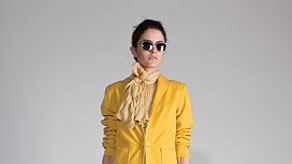
Pre-Spring collections seem to be suffering from an identity crisis: Depending on the designer, the collections (which typically hit store racks in December) may sport the moniker of "Resort," "Cruise," or, simply, "Transition." A slight case of schizophrenia aside, the collections, which got under way this week, hold significance for the fashion industry and beyond. While a select group of fashion heavyweights like Karl Lagerfeld for Chanel, Oscar de la Renta, Diane Von Furstenberg, and, first time Resort show participant and first lady favorite, Jason Wu, are all staging presentations this season, numerous designers are sitting on the sidelines. In place of a theatrical presentation on the Lido in Venice (the setting of Lagerfeld's Death in Venice-inspired presentation for Chanel, which took place earlier this week), the latter are serving up a more financially viable offering: look books. But, what does it all mean for mainstream consumers?
With the international workforce garnering less and less vacation time, what once served as a capsule collection of everything one might need for a mid-winter jaunt to St. Barts or Bali now simply stands as transition for spring.
A few things. For starters, the manic monikers appear to be reflective not of indecision, but of a changing market. With the international workforce garnering less and less vacation time, what once served as a capsule collection of everything one might need for a mid-winter jaunt to St. Barts or Bali now simply stands as transition for spring. In the same vein, while collections were once structured to include a series of staple components (the bathing suit, the basic pant and jacket, etc), today, collections tend to be more reflective of a designer or brand's core identity as an increasingly small group of shoppers are looking to pre-Spring for a yacht-appropriate wardrobe. Not to mention, the fruits of pre-Spring hit store floors at the same time Fall collections are going on sale; meaning the former needs to be especially well executed if it wants to compete with recently slashed price points.

As for the presentations themselves, there is a lot of leeway for speculation as to why certain designers stage shows while others abstain. What is certain, however, is that the average consumer didn't care (and probably had never heard of the term "Resort") prior to Style.com putting the annual collections online (in 2006) and simultaneously commemorating pre-Spring as a sartorial happening worth following. So the fact that only a handful of heavyweights are putting on presentations to herald their pre-Spring designs seems to parallel the fact that the designers in question are feeding a clientele that really does vacation on yachts and require a ball gown for holiday season social gallivanting. Dior is the exception to the rule this year: While last year's Dior Cruise presentation welcomed the likes of Jennifer Lopez and Charlize Theron, this year John Galliano opted to forgo a formal show.
In the same token, while many Americans spend these increasingly warm summer days confined to a cubicle, clicking through slideshows of over-the-top Resort presentations may prove the perfect in-office escape. And the collections themselves so far have been anything but bland. Yves Saint Laurent's Stefano Pilati payed homage to the French fashion house's founder with the kind of classic staples longtime YSL muse Loulou de la Falaise would have approved (balloon sleeves and high-waisted, pleated trousers accented with bohemian accessories, for instance). Dior's John Galliano likewise was eccentric, with his high-drama collection that included turbans and a variety of takes on Dior's classic Bar jacket.

Meanwhile, Bottega Veneta focused on a sportier approach to spring, infusing finely tailored separates with an overall relaxed feel. Oscar de la Renta was all about theatrics, presenting a collection with a decidedly Parisian feel. Staged in a Park Avenue abode with plenty of Vogue editors on hand, the show was anything but understated. Zac Posen kept things sculptural and relatively simple, showcasing looks fit for style icon Nan Kempner circa her Studio 54 days (think asymmetrical cocktail dresses and oversize bows and big collars on a handful of looks). Cinched waists, one-shouldered dresses and balloon shoulders were likewise big at Michael Kors. Narciso Rodriguez followed suit with waist-accents a plenty and cropped trousers. Prada, on the other hand, paired a colorful palette with sumptuously draped deconstructed garments, as well as a bevy of mismatched prints (which altogether created vivid, complimentary combos).
On the opposite end of the spectrum, Zero + Maria Cornejo (Michelle Obama is also a fan of this line) featured pared-down silks and simplicity at its best. And, if Marc by Marc Jacobs has its way, the recent ‘80s resurgence in fashion is here to stay (Jacobs' self-proclaimed inspiration for pre-Spring was Footloose after all). But, perhaps the most high-spirited and immediately captivating collections were those of Rachel Roy, who summed up her inspiration as "Scuba Pop," and Donna Karan, who dubbed her collection "Manhattan Tango." The theme at the former included neoprene and a highlighter palette (which rumor has it Jason Wu's collection, slated to debut later this week, will likewise include), while the latter would be ideal for late-night salsa dancing anywhere south of 14th Street or in Miami. Whether or not the economy is kicking back into shape by December, we'll have to wait and see. Regardless, there'll be plenty of quality fashion to covet come wintertime.
Plus: Check out Fashion Beast, updated every Wednesday, for more news on the latest runway shows, hot designers, and emerging trends.
Alisa Gould-Simon is a Brooklyn-based freelance writer. She also covers fashion and culture for BlackBook, New York and PAPER among other publications.






